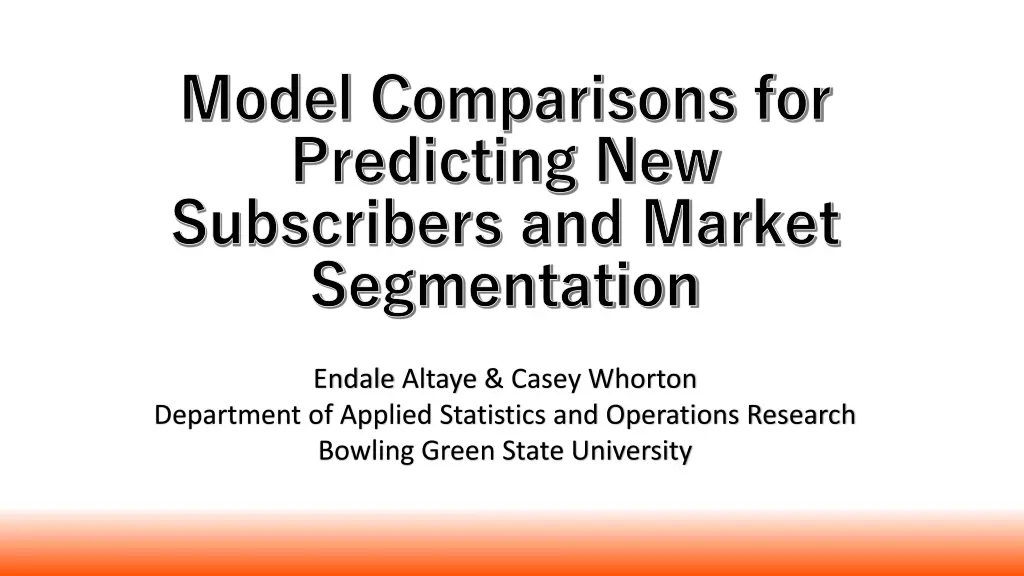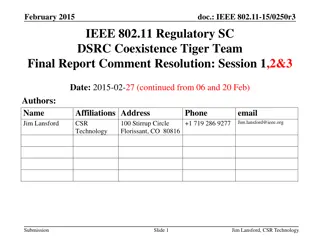
Model Comparisons for New Subscribers & Market Segmentation Study
Explore a study on predicting new subscribers and market segmentation through model comparisons by a team from Bowling Green State University, focusing on client records, problem statements, objectives, model selection, and implementation using random forest modeling.
Download Presentation

Please find below an Image/Link to download the presentation.
The content on the website is provided AS IS for your information and personal use only. It may not be sold, licensed, or shared on other websites without obtaining consent from the author. If you encounter any issues during the download, it is possible that the publisher has removed the file from their server.
You are allowed to download the files provided on this website for personal or commercial use, subject to the condition that they are used lawfully. All files are the property of their respective owners.
The content on the website is provided AS IS for your information and personal use only. It may not be sold, licensed, or shared on other websites without obtaining consent from the author.
E N D
Presentation Transcript
Model Comparisons for Predicting New Subscribers and Market Segmentation Endale Altaye & Casey Whorton Department of Applied Statistics and Operations Research Bowling Green State University
Presentation Outline Background information Objectives Modeling Implementation Market segmentation Sample Conclusion and recommendations 1
Background Information Over 37,000 client records 4,000 client records 19 characteristics and subscription status Demographics Relationship to bank Previous marketing information 2
Problem Statement Which clients have the best chance of saying yes to a long term deposit? 3
Objectives All clients Group 2 Group n Group 1 Create model Market segmentation 4
What We Want Records for clients we want to contact about subscribing to a bank s term deposit ? Chances of each client subscribing Name Job Loan Subscribe Name Job Loan Subscribe John S. admin No ? John S. admin No 90% Mary J. CEO Yes ? Mary J. CEO Yes 25% ? 60% 5
Finding The Best Prediction Model Try 5 models and compare Client records 6
Training Data and Test Data Original client records Create models 60% of data Evaluate & compare models 40% of data 7
Model Selection Misclassification Rate Specificity Sensitivity Precision 0.0890 (3) 0.9749 (1) 0.4093 (5) 0.6747 (1) Logistic Linear Discriminant Analysis 0.0891 (4) 0.9384 (5) 0.6285 (1) 0.4982 (5) Quadratic 0.1363 (5) 0.9419 (3) 0.4224 (4) 0.5632 (3) Discriminant Analysis 0.0886 (2) 0.9398 (4) 0.6278 (2) 0.5108 (4) Decision Tree 0.0858 (1) 0.9633 (2) 0.5246 (3) 0.6429 (2) Random Forest Winning model: Random Forest 8
Implementation Random Forest Model Chose 400 with best chances of subscribing 4,000 client records Name Job Loan Subscribe Name Job Loan Subscribe John S. admin No 52% John S. admin No ? Mary J. CEO Yes 10% Mary J. CEO Yes ? ? ? 9
Objectives All clients Group 2 Group n Group 1 Create model Market segmentation 11
How Do We Separate Clients Into Groups? Group 1 K-means Clustering Method Group 2 Algorithm for sorting clients into groups Group n All clients 12
Market Segmentation Proportion within group Groups Subscribers Group 20 groups total 7 groups have good subscription rates 13
Group B Group A Retired Mostly married Variety of ed. levels Most have no home loan Students Mostly single High school or university education 30.5 % of clients said yes 25.5 % of clients said yes Overall: 11% of clients said yes 14
Objectives All clients Group 2 Group n Group 1 Create model Market segmentation 15
Conclusion and Recommendations Group A Random Forest Model List of clients in the group that have the best chance of subscribing Students Mostly single High school or university education Prioritize groups with high proportion of subscribers Tailor marketing to groups Utilize the Random Forest Model for large groups Save resources 16
Thank you Thank you 17





















